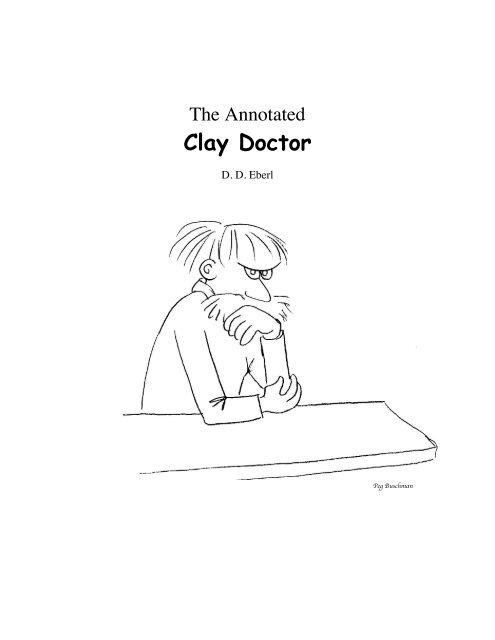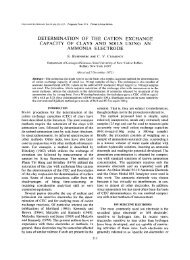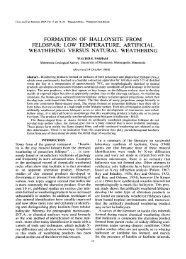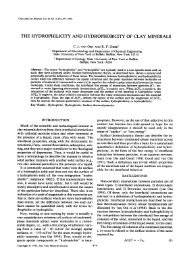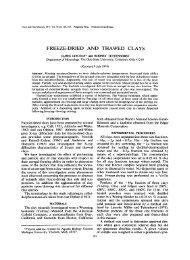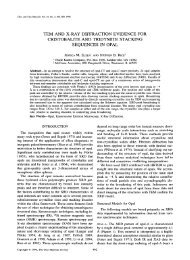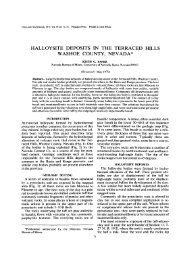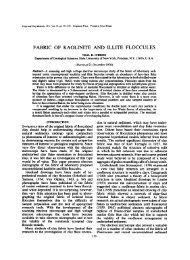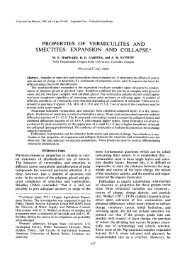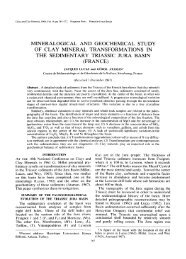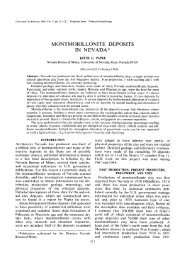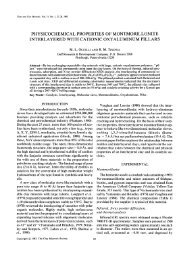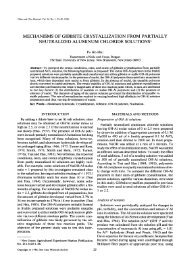Clay Doctor - Clay Minerals Society
Clay Doctor - Clay Minerals Society
Clay Doctor - Clay Minerals Society
Create successful ePaper yourself
Turn your PDF publications into a flip-book with our unique Google optimized e-Paper software.
The Annotated<br />
<strong>Clay</strong> <strong>Doctor</strong><br />
D. D. Eberl<br />
Peg Buschman
For Karuna, Jo and Luke<br />
Christmas 2008<br />
2
Introduction<br />
I dreamed up Ask the <strong>Clay</strong> <strong>Doctor</strong> for The <strong>Clay</strong> <strong>Minerals</strong> <strong>Society</strong> (CMS)<br />
Newsletter, which my wife, Jo, started and edited as a part of her job as the <strong>Society</strong>’s<br />
manager. At first I thought it would be an advice column, where scientists would write in<br />
to ask, for example, “What do you do when clay peels off the X-ray slide?” And I would<br />
reply, “Put some scotch tape on it.” But then I realized that: (1) no one would write in;<br />
and, (2) no one would read the column, because it would be too boring. So I made up<br />
both questions and answers, and an offbeat persona was born.<br />
At that time, NPR had a comedy feature (by the Firesign Theatre) called Ask Dr.<br />
Science. “Dr. Science is smarter than you are, because he has a Master’s degree---in<br />
Science!” This radio program inspired the <strong>Clay</strong> <strong>Doctor</strong>, who is part Dr. Science, part<br />
Dear Abby, part Zen koan, part Jack Handey. Some examples of Jack Handey’s humor:<br />
“If trees could scream, would we be so cavalier about cutting them down? We<br />
might, if they screamed all the time, for no good reason.”<br />
“I think there should be something in science called the "reindeer effect." I don't<br />
know what it would be, but I think it'd be good to hear someone say, "Gentlemen, what<br />
we have here is a terrifying example of the reindeer effect."”<br />
“Somebody told me it was frightening how much topsoil we are losing each year,<br />
but I told that story around the campfire and nobody got scared.”<br />
Not everyone will find Jack Handey funny.<br />
Bill Johns said that the column should be called “Ask Dr. <strong>Clay</strong>,” but I liked “The<br />
<strong>Clay</strong> <strong>Doctor</strong>” better, because it sounded clunkier, and, therefore, funnier. Beneath the<br />
column’s title was the line, “Not a real doctor.” Some scientists may be unaware that<br />
having a Ph.D. does not make them a real doctor. Ask a Jewish mother.<br />
I did not put my byline on the column so that other people could send in their<br />
ideas too: there would be many clay doctors. Mostly, only questions were sent in, which<br />
the <strong>Clay</strong> <strong>Doctor</strong> parried, often with devastating results for the questioner. Some people<br />
got the joke, and sent in both questions and answers. But to me these <strong>Clay</strong> <strong>Doctor</strong>s did<br />
not seem as funny; so, although they were published in the newsletter, they are, for the<br />
most part, not included here. Sorry Warren.<br />
After Jo quit the CMS job, and the newsletter folded because no one came along<br />
with Jo’s originality and energy to keep it up, other <strong>Clay</strong> <strong>Doctor</strong>s were written in the<br />
form of essays rather than as questions and answers. Some of these were submitted to<br />
Elements magazine, but most were rejected: Not funny enough? Not serious enough?<br />
Too funny? Too risqué? They never said. Elements is a slick publication put out by<br />
several scientific societies, including the CMS. It is fairly new, and it may have been<br />
partly inspired by Jo’s newsletter. Recently, the editor for the CMS section of Elements<br />
(Steve Hillier) said that the <strong>Clay</strong> <strong>Doctor</strong> was missed; so I sent him more nonsense to see<br />
if it would clear the overall editor. It did not. Mineralogy, after all, is a serious business.<br />
3
Below is a collection of <strong>Clay</strong> <strong>Doctor</strong>s, with commentaries that discuss some of the<br />
history and humor behind the stories. Except for the first piece, the failed essays to<br />
Elements are presented first, followed by questions and answers that appeared in the<br />
CMS newsletter.<br />
4
How I Won the Reynolds Cup<br />
The <strong>Clay</strong> <strong>Doctor</strong><br />
Dept. of Earth, Wind, Fire and Water Sciences, <strong>Clay</strong>head University,<br />
9-10 Big Fat Hen Road, Rockland, BA 00002<br />
I suddenly became interested in minerals at a very young age, when other kids<br />
began to throw rocks at me. Rocks that contained clay hurt less; so I began to wonder<br />
how much kaolinite is in this one, how much galena in that. My father bought me my<br />
first X-ray diffractometer when I was 10, and there was no turning back. While other<br />
children were reading Tales from the Crypt Comics, and later Hustler Magazine, I was<br />
reading the X-ray Powder Diffraction Card Files, memorizing d-spacings. So when Dr.<br />
Douglas McCarty from Chevron-Texaco sent me the three unknowns that contained<br />
mixtures of pure mineral separates, I was ready to analyze them quantitatively.<br />
I analyzed the samples as follows. They came in the mail in an Airborne Express<br />
pouch. I opened the pouch with a dry-wall knife that is kept in the second drawer from<br />
the top in the X-ray lab. It is the type that has a retractable blade. Then the bottles were<br />
removed from the package, and I analyzed them.<br />
I am so undeserving of this honor, but am happy to have become the first winner<br />
of the Reynolds Cup. I would like to thank my parents, my music teacher, and the little<br />
gal who let me turn left into the parking lot this morning. I especially thank Dr. McCarty<br />
for mistakenly sending me the answers along with the bottles, which saved a lot of<br />
analysis time. I realize that in accepting this award I will be responsible for helping to<br />
organize the next competition. Also, I understand that the Cup is not permanently mine,<br />
but that it will circulate to the next winner. Therefore, in some ways, the Reynolds Cup<br />
is similar to the Stanley Cup, except for the hockey. Now I kiss the Cup, raise it above<br />
my head, and run around the meeting room yelling, wrapped in a flag.<br />
In the (unlikely) event that I do not win, I will relinquish this time at the podium<br />
to the real winners so that they can explain how they won the Reynolds Cup.<br />
Commentary<br />
Kathy organized a CMS meeting in Boulder in 2002, and asked me for a<br />
contribution by the <strong>Clay</strong> <strong>Doctor</strong>. I sent her the above abstract, to be published in the<br />
meeting’s abstract volume. It was meant to be funny, but also to delineate rules for the<br />
newly instituted Reynolds Cup competition. Then I missed one of the organizational<br />
meetings, and I think that Kathy took offense, because she did not put the abstract in the<br />
volume. I would not want to call her a bitch. Later, she did release it as a flyer at the<br />
meeting, with an apology. I was a little disturbed, but later got my revenge.<br />
The Reynolds Cup is an international competition in quantitative mineral analysis<br />
started by Jan Srodon, Dougal McCarty and me. It was started to improve mineral<br />
analysis methods, which then were being done very poorly in most labs. The contest is<br />
named after Dougal’s and my geology professor at Dartmouth, Bob Reynolds. I asked<br />
Bob if he wanted the prize to be a trophy or a cup, and he said a cup.<br />
5
I made the cup from rocks bought at Roy Young’s store (Nature’s Own): two<br />
bookends, made of polished, black, Moroccan limestone that contained belemnite fossils,<br />
were glued together, and topped by a large, beige-colored mortar and pestle composed of<br />
a fossiliferous limestone from Pakistan. The cup’s symbolism denoted that this is a<br />
working-analyst’s prize. The samples could be ground with the Cup’s mortar and pestle.<br />
On one side of the trophy, a quarryman from the Tribble Stone Company inscribed,<br />
“Reynolds Cup” in fancy letters. On the other side was inscribed, “Champion,<br />
Quantitative Mineral Analysis.” I wanted the winner to be called a champion, because<br />
anyone devoted enough to win the Reynolds Cup probably never had that opportunity,<br />
and because the Reynolds Cup was to be a fierce competition, like the Ultimate Cage<br />
Fighting Championship, but without the punching, hugging and rolling around on the<br />
floor.<br />
So the <strong>Clay</strong> <strong>Doctor</strong>, ever confident, sent in an abstract proclaiming that he had<br />
won the Reynolds Cup, even though the contest had not yet been judged. The <strong>Clay</strong><br />
<strong>Doctor</strong> is from the Department of Earth, Air, Fire and Water. When I went to college,<br />
such places were called geology departments. Then, as funding sources changed, so did<br />
the names, from Department of Earth Sciences, to Department of Environmental<br />
Sciences, to Department of Earth and Planetary Sciences. We’ll call it whatever you<br />
want, just keep the funds flowing. The <strong>Clay</strong> <strong>Doctor</strong>’s departmental name covers the<br />
ground, and has returned to science’s alchemical roots.<br />
The abbreviation for the state, where his department is located, is “BA,” which is<br />
a trap. I thought no one would ever fall into this trap, but then Kathy asked me, “What<br />
does BA mean?” I answered, “BA means Bad Ass. You win the Bad Ass Award!” She<br />
said, “No, I don’t!” Unexpected revenge is so sweet! There must be a God. If there is<br />
no God, then at least there must be a Jesus.<br />
The <strong>Clay</strong> <strong>Doctor</strong> can’t just accept his award quietly, with humility and gratitude.<br />
Rather, he needs to tell us his life’s story. As a young boy, instead of wondering why<br />
6
kids are throwing rocks at him, whether there is some character flaw that he can correct,<br />
or instead of getting to the root of the problem by confronting the other kids, he studies<br />
the rocks that hit him, with the ineffective strategy of measuring the ones that hurt least.<br />
Do many careers in science start this way? The kids who attacked him were<br />
mineralogically sophisticated: they didn’t just throw rocks, they threw galena crystals,<br />
which are made of lead, which hurt like crazy.<br />
This poor kid never had a chance. His father bought him a $100,000 instrument<br />
when he was 10. The thinking was (maybe still is) that kids should begin their career<br />
training early, so that they can compete when they grow up. That is how America will<br />
beat the Russians (Japanese/Chinese/Falkland Islanders). However, wouldn’t it have<br />
been better for the young <strong>Clay</strong> <strong>Doctor</strong> to have fun, to read comics rather than to serve the<br />
corporate masters?<br />
“Dr. Douglas McCarty,” that is a joke in itself. I do not think that anyone would<br />
have predicted that a juvenile delinquent from Bozeman would have become such a fine<br />
scientist. Doing his B.S. with Gray, and his Ph.D. with Reynolds helped a lot, and now<br />
he works with Victor Drits. Smart guy. Lucky guy to have been both a delinquent and a<br />
scientist.<br />
The <strong>Clay</strong> <strong>Doctor</strong> says that he is going to tell you how he analyzed the Reynolds<br />
Cup samples, and then tells how he opened the sample box. Later we learn how he won<br />
the Cup: he cheated.<br />
He thanks everyone, his parents, his music teacher (because you always have to<br />
thank your music teacher), and reveals himself to be a sexist pig by thanking the “little<br />
gal.” One can imagine a woman in a car, waiting for him to turn left, waving him on,<br />
saying to herself, “Come on, turn, you old fart!”<br />
When I started to study geology, there were no women in the science, and it was<br />
common for speakers to make sexist remarks, even show slides of nudes while making<br />
manly jokes. When this atmosphere changed, it changed fast. Some scientists were<br />
caught off guard, not knowing about the change during their interview lecture, and were<br />
not hired as departmental chairman. Calling the woman a “little gal” in this piece is a<br />
retro joke, and you can hate the <strong>Clay</strong> <strong>Doctor</strong> for it, rather than me.<br />
The first person to win the Cup is a great guy, Reinhard Kleeberg, from East<br />
Germany. Years ago he was an East German soldier, guarding the Communist side of the<br />
Berlin Wall, listening to a Rolling Stones concert coming from the western side. One<br />
night he almost shot someone who he thought was trying to cross the wall. His finger<br />
almost squeezed the trigger. He barely held back. At that time, East Germans were<br />
demonized by the West. Now we find that they had wonderful scientists and people like<br />
Reinhard.<br />
7
Streaking Towards Mars: Faster, Cheaper, Dumber<br />
Rather than launching expensive and delicate spectrometers and diffractometers<br />
to study Martian mineralogy, NASA would be well advised to send an inexpensive and<br />
sturdy tool that is used in beginning mineralogy classes. The streak plate, a simple piece<br />
of unglazed porcelain tile, reveals diagnostic colors for minerals that are scratched on its<br />
surface. For example, the characteristic streak for quartz is white, whereas that for halite<br />
is white, and that for gypsum also is white. Such accuracy and precision is impressive for<br />
any technique, but these analyses are surpassed by the streak plate’s power to distinguish<br />
specular hematite from galena. Both minerals are silvery grey in hand specimen, but one<br />
streaks dark red, whereas the other streaks gray. It is important to discover which<br />
mineral is on the Martian surface, because the presence of specular hematite means that<br />
water was present, and water means life; whereas, the presence of galena means that lead<br />
is present, and lead means Superfund cleanup. Given a robotic arm long enough, and a<br />
place to streak, this technique can analyze a world!<br />
<strong>Clay</strong>.doc<br />
Winter 2008<br />
Commentary<br />
This essay, rejected by Elements magazine, offers a modest suggestion to help<br />
NASA’s “Faster, Better, Cheaper” policy, which ended up dropping a space probe on a<br />
laboratory floor, and crashing several others into Mars. NASA claimed that they chose a<br />
certain Martian landing site because an orbiting spectrometer showed that specular<br />
hematite was present in a crater, and they knew that the presence of hematite means that<br />
water was present. I pointed out on MSA-Talk that hematite did not need water to form,<br />
and I was backed up by other scientists. One wrote to me and said, “The Emperor has no<br />
clothes, right?” However, the Mars lander did find millions of hematite spheres at the<br />
site, which were dubbed “Martian blueberries.” One idea is that these blueberries are<br />
glass spherules formed by molten rock thrown up by meteorite impact. Another<br />
suggestion is that they are concretions formed from solutions that flowed through the<br />
rocks. A Frenchman (Denis Royer) measured their size distributions from Opportunity<br />
Rover photos, and I found that these distributions fit exactly our crystal growth theory.<br />
According to this approach, the blueberries in the Eagle Crater formed initially by<br />
Ostwald ripening, and those on the Victoria Crater rim formed by proportionate growth,<br />
both occurring in water. I went to the Utah desert to study similar concretions, called<br />
Moqui Marbles or Moqui Balls, got lost in the desert, but luckily found my way out with<br />
a GPS unit. I shouldn’t have been wandering there alone. I took photos of the Moqui<br />
Marbles, and Royer was going to measure their size distributions from the photos, but he<br />
lost interest when his wife died suddenly. So now there is an excuse to go to the desert<br />
this fall. I need a field assistant. Any volunteers?<br />
The last sentence in the essay paraphrases Archimedes’ famous exaggeration,<br />
“Give me a lever long enough, and a place to stand, and I shall move the World.”<br />
9
Let Us Eat <strong>Clay</strong>ke<br />
I have combined equal parts clay (Wyoming bentonite) with Betty Crocker<br />
chocolate cake mix, baked it, and have invented a food supplement that not only tastes<br />
good, but that is very good for you. The cake part tastes good, whereas the bentonite part<br />
fills you up and absorbs toxins. The bentonite even absorbs toxins that may come from<br />
the cake mix. Upon digestion, the bentonite toxin-rich paste then is excreted and<br />
recycled. The bentonite is purified and used as before, and the toxins are reprocessed,<br />
refined, and turned into useful products, such as lead-cadmium storage batteries and rat<br />
poison. I have filed a patent for this process, and I thank the editors for publishing this<br />
note to establish priority.<br />
<strong>Clay</strong>.doc<br />
Summer 2008<br />
Commentary<br />
Those are some toxins that the clay absorbs. Like many environmentally correct<br />
ideas, this one may be hard to implement. This note was meant for the bentonite issue of<br />
Elements. I take back my thanks to the editors for publishing it.<br />
10
MEETING ANNOUNCMENT<br />
First International Meeting of the Transectual <strong>Society</strong><br />
Palace Hotel, San Francisco<br />
October 15 to 31, 2007<br />
Join us for the first annual meeting of the Transectual <strong>Society</strong>, a society devoted<br />
to the use of transects to study planet Earth. This powerful approach to science has<br />
distinguished roots with 19 th century and early 20 th century explorers: Robert Peary,<br />
Lewis and Clark, and Robert F. Scott, to name a few, were all transectuals, There will be<br />
a pre-meeting workshop entitled: “Planetary Transects of Mars, Jupiter, Uranus, and<br />
Beyond”. The second day will feature a keynote address by California Senator Barbara<br />
Boxer entitled, “Great Transectuals and their Transects.” The mid-meeting field trip will<br />
take 10 days to transect the Death Valley graben on foot, including the adjacent mountain<br />
ranges. Good hiking boots and a canteen are required! Other special sessions include:<br />
“Soil Transects of North America,” being organized by Professor I. M. Grubby from<br />
Harvard University; “What Ice Cores from the 2006 Greenland Transect Tell Us: We<br />
Don’t Know” by U. R. Knott and his research group at Naropa University; and<br />
“Transects and Tangerines: Recent Equatorial Traverses,” by Hooptagupta Ganymede.<br />
We will be happy to see you and to hear your paper at the meeting, and you will be glad<br />
to see us on your resume. For more information please consult our website:<br />
www.claydoctor.org.<br />
Commentary<br />
Elements wouldn’t publish a simple meeting announcement! There is much to be<br />
said in favor of the CMS publishing its own uncensored newsletter, especially when our<br />
society pays tens of thousands of dollars for the privilege of being in Elements.<br />
11
Nanoscience is <strong>Clay</strong> Science<br />
Fans have asked for my nanothoughts concerning the last issue of Elements<br />
magazine. Being a clay scientist, I have worked with Angstrom units for my entire<br />
career. But with the aid of specialized software and my IBM XT 286 computer, now I<br />
am up to date. I even discovered a shortcut for converting Angstroms into nanometers in<br />
my head. It is necessary only to move the decimal point one place to the left. By this<br />
method, 10 Å illite becomes 1 nm illite, and clay science enters the wonderful funding<br />
world of nanotechnology.<br />
An important advance was made in this manner several years ago when a brilliant<br />
scientist, by accident, but working with a prepared mind, moved the decimal point one<br />
place in the wrong direction, thereby discovering the ninnymeter. The name of that<br />
scientist was Alfred E. Ninny, and the rest is history. Unfortunately, the ninnymeter has<br />
the same abbreviation as the nanometer (nm), leading to confusion in the literature. For<br />
this reason, some scientists have decided to retain the Å, and their work can be<br />
distinguished by the presence of a big A and a tiny A hole.<br />
I congratulate the editors and authors of Elements for the excellent nanoscience<br />
issue. I rate it four out of a possible four quantum dots. However, I should like to see a<br />
similar issue devoted to ninnyscience, to be written by the top ninnyscientists. After all, a<br />
ninnymeter is two orders of magnitude smaller than a nanometer, and therefore is exactly<br />
100 times more interesting. A ninnyissue would encourage the present trend to explore<br />
smaller and smaller objects, taking us closer to the ultimate goal of realizing everything<br />
there is to know about nothing at all.<br />
12
Dear <strong>Clay</strong> <strong>Doctor</strong>: I have just read Cairns-Smith and Hartman’s book (<strong>Clay</strong> <strong>Minerals</strong><br />
and the Origin of Life) in which clays are considered to be inorganic precursors to<br />
organic life forms, and I was wondering: do clays have a sex life?<br />
Really Interested, Missoula<br />
Dear Really: <strong>Clay</strong> Mineralogists have long been trying to discover what goes on<br />
between the sheets. The problem has been to determine whether a particular clay is male<br />
or female. For some clays, such as dickite, the answer is clear enough; but for others the<br />
answer demands years of study. In one experiment, I put a sample of halloysite next to a<br />
particularly voluptuous piece of montmorillonite, and detected panting.<br />
Commentary<br />
Reynolds said that he laughed out loud when he read the part about the sheets,<br />
which is a double entendre concerning the structure of clays, which have sheet-like<br />
arrangements of atoms. Maybe clay scientists are naive about such things. The dickite<br />
joke goes back to the venerable Dartmouth professor, Dick Stoiber, who curated a locked<br />
display case in the Geology Department, one that featured a new mineral every week.<br />
One morning the display contained a penis-look-alike mineral with the label, “Dickite.”<br />
“Who would do such a thing?” asked Dick innocently. “I am the only one who has the<br />
key!” Sometimes Dick would party most of the night, and then lecture his 8 AM class<br />
lying on his back on a desk, gesturing to the ceiling. True clay scientists can understand<br />
it when montmorillonite is termed “voluptuous,” can empathize with halloysite’s great<br />
interest in this swelling clay, and can pity their lack of ambulatory powers.<br />
13
Dear <strong>Clay</strong> <strong>Doctor</strong>: I am so confused. What is the difference between an Angstrom and a<br />
nanometer?<br />
Fill me in, Binghamton<br />
Dear Fill: The conversion from nanometers (nm) into angstroms (Å) is quite simple: use<br />
the formula nm = 5/9 (Å-32); or even more simply, move the decimal point one place to<br />
the left. Moving the decimal point in the opposite direction (i.e., one place to the right),<br />
converts angstroms into ninnymeters, which, unfortunately, have the same abbreviation<br />
as nanometers (nm). Ninnymeters were discovered by Alfred J. Ninney, who found that<br />
illite has a 100 nm X-ray peak. The rest is history.<br />
Commentary<br />
The equation given actually converts degrees Fahrenheit into degrees centigrade.<br />
A distinguished clay scientist from Israel actually did write a paper in which he moved<br />
the decimal point in the wrong direction. The <strong>Clay</strong> <strong>Doctor</strong> almost used his name, but<br />
then decided that he wouldn’t like to be reminded.<br />
Dear <strong>Clay</strong> <strong>Doctor</strong>: I like clay minerals, and I also like professional football. If Joe<br />
Montana, quarterback for the San Francisco 49ers, were a clay mineralogist, what clay<br />
would he study?<br />
<strong>Clay</strong> fan, Houston<br />
Dear <strong>Clay</strong>: Nontronite.<br />
Commentary<br />
This may be the most sophisticated <strong>Clay</strong> <strong>Doctor</strong>. The questioner wants to<br />
combine two loves, clay mineralogy and professional football. It is like the climber Boyd<br />
Everett, who loved climbing, bridge and golf. So he drove a ball off the north face of Mt.<br />
Logan in the Yukon, and played the highest game of bridge in history on its summit.<br />
What clay would Joe Montana study if he studied clay? Who can answer such a<br />
question? It is like asking a Zen Master, “What is the meaning of life?” How the hell is<br />
he supposed to know? However, the <strong>Clay</strong> <strong>Doctor</strong> is such an expert on clay that he can<br />
answer even this question, and the answer is the iron-rich clay, nontronite.<br />
14
Dear <strong>Clay</strong> <strong>Doctor</strong>: The other day I was in the farmyard feeding zeolite to my chickens<br />
(zeolite keeps the smell down and helps make the egg shells stronger), and I got to<br />
wondering, which came first, the chicken or the egg?<br />
Farmer Brown, Brockport<br />
Dear Farmer Brown: Thank you for your interesting question. Profound thoughts such<br />
as yours often occur to people who handle clay-size material. The answer to your<br />
question, however, is quite simple and quite obvious: of course, the chicken came first.<br />
How else could there be an egg?<br />
Commentary<br />
Farmer Brown is Fred Mumpton, a scientist who wore suspenders, was editor of<br />
the CMS journal for many years, and lived in Brockport. The chicken-egg argument was<br />
inspired by talk given in Hyde Park, London, by a tanned little Englishman who, naked<br />
except for a pair of shorts, gave a talk on the subject to a large crowd, and who, like the<br />
<strong>Clay</strong> <strong>Doctor</strong>, completely missed the paradox.<br />
15
Dear <strong>Clay</strong> <strong>Doctor</strong>: I have traveled the world searching for the answer to this one: What<br />
is the most fundamental science? Can you help me?<br />
Truth Seeker, Lubbock<br />
Dear Truth Seeker: Physicists especially will be surprised to learn that clay science is<br />
the most fundamental science. Why is this so? We know from the work of Cairns-Smith<br />
and Hartman (<strong>Clay</strong> <strong>Minerals</strong> and the Origin of Life) that all life came from clay minerals.<br />
Therefore, after a long evolutionary process, the study of clay is nothing less than clay<br />
trying to get to know itself.<br />
Commentary<br />
Hartman and Carins-Smith held a conference in Glasgow on <strong>Clay</strong>s and the Origin<br />
of Life that I attended. This <strong>Clay</strong> <strong>Doctor</strong> is poking fun at them, and their good idea, for<br />
which there is no evidence. A German (Armand Weiss) wrote a highly original paper on<br />
this topic, and he was to be a featured speaker at the conference. Unfortunately, he said<br />
that most of his evidence burned up in a fire, and he never showed up.<br />
16
Dear <strong>Clay</strong> <strong>Doctor</strong>: I was riding my motorcycle through New Hampshire when I noticed<br />
flashes of light coming from the road cuts. On closer inspection, I found that the flashes<br />
were sunlight being reflected from mica flakes! The question then occurred to me: Are<br />
there different kinds of mica?<br />
Biker, Hanover<br />
Dear Biker: I also have found that, next to the petrographic microscope, the best way to<br />
study coarse-grain phyllosilicates is on a bright summer day on a Harley at 80 mph. In<br />
answer to your question, there are three major classes of mica: (1) white mica, which<br />
includes muscovite, commonly found in granites; (2) brittle mica, which includes<br />
margarite, a calcium-rich variety; and, finally, (3) Formica, which includes fornikite,<br />
commonly found in Australia.<br />
Commentary<br />
This is one of several <strong>Clay</strong> <strong>Doctor</strong>s that were aimed at Bob Reynolds, who rode a<br />
motorcycle around Hanover, New Hampshire. There actually is such an outcrop that is<br />
visited by Dartmouth students. Formica, of course, is not a mica at all, but is used to<br />
cover kitchen counters. “Fornikite” uses the Australian pronunciation: “Do you like ta<br />
fornikite, myte?”<br />
Bob Reynolds with his dirt bike<br />
17
Dear <strong>Clay</strong> <strong>Doctor</strong>: I’ve been having one heck of a time preparing stable clay<br />
suspensions. First I disperse the clay in salt water using ultrasonics, and then I spin it in a<br />
centrifuge for the time recommended by Jackson; but when I open the centrifuge, the clay<br />
always has settled to the bottom of the centrifuge tube. I’ve tried it with kaolinite; I’ve<br />
tried it with montmorillonite; and I’ve tried it with illite—all with the same result. What<br />
do you suggest?<br />
Suspended, Paris<br />
Dear Suspended: Have you tried it with hectorite?<br />
Commentary<br />
Anyone who deals with clay knows that the problem is that the writer is using salt<br />
water, which causes the clay to flocculate. The <strong>Clay</strong> <strong>Doctor</strong> reveals his ignorance by<br />
telling him to try another clay, rather than to use distilled water.<br />
Dear <strong>Clay</strong> <strong>Doctor</strong>: Regarding your last column, I do not correlate Joe Montana with<br />
nontronite. Is it non-throw-tonight—yet that doesn’t seem right for Joe? Or is it that Joe<br />
Montana’s name is “mud” to Coloradoans?<br />
Walter D. Keller, Columbia<br />
Dear Prof. Keller: The reason Joe Montana, given the chance, would study nontronite<br />
should be fairly obvious. It is the same reason for which Michael Jordan would study<br />
berthierine.<br />
Commentary<br />
Professor Keller was nearly 100 years old when he wrote this; so he should just<br />
shut up about the 49ers beating the Broncos. He also wrote to say that he didn’t<br />
understand why halloysite would be panting over montmorillonite.<br />
18
Dear <strong>Clay</strong> <strong>Doctor</strong>: What are future directions for research in clay mineral<br />
crystallography?<br />
Refined Structure, Madison<br />
Dear Refined Structure: In the future, clay crystallographers will not use noxious<br />
radiations, such as X-rays, to study clays. <strong>Clay</strong>s have been ultra violated long enough!<br />
Tomorrow’s crystallographers will grow giant clay crystals. Then the structure of<br />
montmorillonite, for example, will be determined directly, as it should be, by walking<br />
through the crystal with a protractor and a meter stick. Wait! Did you remember to<br />
neutralize you static charge before coming in here? Look out! Here comes an interlayer<br />
cation!<br />
Commentary<br />
The “refined structure” from Madison was Sturgis “Bull” Bailey, a distinguished<br />
crystallographer. However, despite its sophistication, crystallography seems to be mainly<br />
about measuring distances and angles, which could be done much more conveniently in<br />
giant clays with a protractor and a meter stick.<br />
Bull Bailey<br />
19
Dear <strong>Clay</strong> <strong>Doctor</strong>: One of my colleagues maintains that only large crystals (the larger<br />
the better) have healing and psychic powers. On the other hand, I believe that<br />
microscopic crystals, especially clays, can have very powerful healing and soothing<br />
effects. Who is right?<br />
New Age, Mendocino<br />
P.S. Why does your byline carry the disclaimer “not a real doctor”?<br />
Dear New Age: From a completely impartial viewpoint, I will have to side with clay.<br />
<strong>Clay</strong> frequently is used in medicines, not only because it is soothing, but also because it is<br />
the cleanest substance. By definition, clay is the finest matter; therefore, nothing finer<br />
can cling to it. In other words, clay can never get dirty because it already is dirt. Another<br />
reason for its use is that it is, quite literally, dirt-cheap.<br />
There is a large literature devoted to the miraculous properties of clay. For<br />
example, a monochromatic X-ray beam shined on clay will be reflected, but only at<br />
certain angles. Some clays emit bursts of light when dried, and can be fired to produce<br />
the finest porcelain. Other clays store and provide essential nutrients for growing plants.<br />
Magical stuff!<br />
However, there is one strange incident to report. Late one evening, when X-<br />
raying a CMS Source <strong>Clay</strong>, the plotter pen, instead of tracing the 7 Å peak for kaolinite,<br />
wrote in large, scrawly letters, “This is Satan. You are my slave, human scum. Stick<br />
your head in the X-ray beam.” I called the Siemens repairman. He sprinkled holy water<br />
on the X-ray tube, and it sizzled. I haven’t had any trouble since, except that, every now<br />
and then, the plotter pen runs out of ink.<br />
P.S. I am not a real doctor because I do not have a doctorate in reality.<br />
Commentary<br />
The second paragraph reminds one of a Zen miracle, such as: “When rain falls,<br />
the ground gets wet.” Another miracle would be for a plotter pen, which usually moves<br />
with such precision and speed, to begin to write in large, scrawly letters. Derek Bain<br />
liked the last line, agreeing that the P.S. comment was true.<br />
20
Dear <strong>Clay</strong> <strong>Doctor</strong>: Why are large kaolinite deposits not found in early Paleozoic rocks?<br />
Mud Dauber, Columbia<br />
Dear Mud Dauber: This question is beyond my ken; therefore, I must refer you to the<br />
<strong>Society</strong>’s kaolinite expert, Professor Walter Keller at the University of Missouri,<br />
Columbia. He should know what happened to early Paleozoic clays, because he was<br />
there. However, I disagree with Dr. Keller’s assessment, stated in the last newsletter, that<br />
kaolinites are finicky vegetarians. I have never known a kaolinite deposit to refuse a<br />
good stake.<br />
Commentary<br />
“Mud Dauber” is actually old Walter Keller himself; so the <strong>Clay</strong> <strong>Doctor</strong> is<br />
referring Dr. Keller to himself for the answer.<br />
21
Dear <strong>Clay</strong> <strong>Doctor</strong>: My colleagues and I were sitting around the lab when the<br />
conversation (as it usually does this time of year) turned to baseball and clay. There was<br />
some talk of Don Mattingly and the New York Yankees, but I was more interested in Bo<br />
Jackson and the Kansas City Royals. Tell me, what clay would Bo Jackson study if he<br />
were a clay mineralogist?<br />
Baseball <strong>Clay</strong>er, East Lansing<br />
Dear Ball <strong>Clay</strong>er: Bo Jackson would study palygorskite, definitely. Don Mattingly<br />
would not study clay. He would join an oil company and go into administration.<br />
Commentary<br />
At the time, Don Mattingly was the highest paid player in baseball. This one is<br />
aimed at scientists who love money and power more than discovery.<br />
Dear <strong>Clay</strong> <strong>Doctor</strong>: Nothing personal, Sir, but I think that your column is a bit flaky, if<br />
you know what I mean.<br />
Humorless Sandstone Petrologist, Cambridge<br />
Dear Sandstone: I do know what you mean. Thank you, Sir. I appreciate it. There is<br />
no higher compliment to one who studies clay than to be called a flake.<br />
Commentary<br />
Can you imagine anything more boring than measuring sand grains under a<br />
microscope? No wonder he is humorless. Luckily, clays occur in flakes that are so small<br />
that they are difficult to measure without automation.<br />
Dear <strong>Clay</strong> <strong>Doctor</strong>: I am looking for a good book on the identification of clay minerals.<br />
Do you have a suggestion?<br />
Illite Illiterate, Chicago<br />
Dear Illite Illiterate: Let me recommend a book entitled, X-ray Diffraction and the<br />
Identification and Analysis of <strong>Clay</strong> <strong>Minerals</strong>, by Moore and Reynolds. This book is a<br />
good investment because, should the text become obsolete, the binding can be used as a<br />
replacement spring for your screen door.<br />
Commentary<br />
This is a great book, but a bit obsolete because it does not include my discoveries.<br />
Nor does any other book. The <strong>Clay</strong> <strong>Doctor</strong> praises the book’s binding.<br />
22
Dear <strong>Clay</strong> <strong>Doctor</strong>: Why is it, through the years, that the French have had such a strong<br />
research interest in clay minerals?<br />
Cherchez le Feuillet, Brussels<br />
Dear Cherchez: The French nation has some of the world’s finest wines and restaurants,<br />
and, perhaps, the finest lifestyle altogether. Therefore, it is natural that they should want<br />
to study the world’s finest minerals. In addition, French scientists long have realized that<br />
research on “la clé” will lead to a key understanding.<br />
Commentary<br />
This is a bilingual pun. “<strong>Clay</strong>” in French is actually “l’argille.” “La clé” means<br />
“the key;” so, naturally, research on la clé will lead to key understandings.<br />
Dear <strong>Clay</strong> <strong>Doctor</strong>: Help! I am desperate. I am a clay mineral in an alpine fault, and I<br />
am not ripening any longer. You should know my nickname is “Ostwald.”<br />
Too Long by Train to Prague<br />
Dear Too Long to Prague: Do not panic. Relax. Have a glass of wine. Put on a<br />
Johnny Mathis record. Change your nickname from “Ostwald” to “Julio.” You will be<br />
ripening again before you know it.<br />
Commentary<br />
A real emergency. The writer is not undergoing Ostwald ripening, and Viagra has<br />
not been invented.<br />
23
Dear <strong>Clay</strong> <strong>Doctor</strong>: If you are a bona-fide <strong>Doctor</strong> of <strong>Clay</strong>s, not a sap-onite, you should<br />
work sympathetically with, or serve, the ill-ites and/or montmor-ill-onites, prescribing<br />
kaolin kaopectate for vermi-culites, and controlling their apatites, assuming they are<br />
living biotites. Non-tronites are exclusive, all-opanes are all-inclusive, and halloysites<br />
were almost hallowed. Friendly paly-gorskites musically cheer on: “atta-pulgite,” old<br />
boy sepiolite, down by the old beidell-ites. Even though you are a tricky dick-ite, keep<br />
you nac-rite. If there is a new unique clay mineral in the K-T boundary, it should be<br />
named dinoend-ellite. Old clay mineral names do not die, they just slake away. Does<br />
that smect-ite (Deutsch)?<br />
Mud Dauber, Columbia<br />
Commentary<br />
Old man Keller again. He was on a bus on a field trip to Scotland lead by Jeff<br />
Wilson. Wilson was being careful not to stress the old man. They stopped near a<br />
vitrified fort, which Wilson was sure no one would want to visit, because the temperature<br />
was freezing, and the rain was horizontal. Keller led a charge off the bus and up the hill.<br />
Jeff Wilson<br />
24
Dear <strong>Clay</strong> <strong>Doctor</strong>: What is the little circle on the top of the “A” that designates the<br />
Angstrom unit (Å)?<br />
Lost in Space, Baton Rouge<br />
Dear Baton Rouge: The little circle, known as an A-hole, is attached to hooks so that<br />
the Angstrom unit, which is very small, can be readily found and used by scientists.<br />
However, this device is crude, at best. One solution to the problem of finding the minute<br />
unit was to invent a hole that emits a high-pitched whine (“screaming” variety). This<br />
invention never became popular because it was too noisy, and sometimes burst into<br />
flames. Therefore, most scientists prefer the silent kind (“dumb” variety). Whereas some<br />
research centers aimed to produce bigger holes, a real breakthrough came with the<br />
discovery of the nanometer, a unit that is ten times larger that the Angstrom. However,<br />
there is little danger that the Angstrom unit will become obsolete. Many purchasing<br />
agents assure us that there will always be an ample supply of dumb A-holes.<br />
Commentary<br />
The <strong>Clay</strong> <strong>Doctor</strong> must have been having some trouble with a Survey purchasing<br />
agent when this one was written.<br />
Dear <strong>Clay</strong> <strong>Doctor</strong>: Another army seems to have gone down the tube. Do you think that<br />
this is the halloysite effect?<br />
Wondering in Washington<br />
Dear Wondering: Most armies are too large to fit down halloysite tubes. However,<br />
halloysite has been used in modern warfare. <strong>Clay</strong> physicists working at Lawrence-<br />
Livermore Lab invented a nanocannon made of halloysite tubes that shoot grapeshot<br />
composed of beta particles. The weapon worked well in the laboratory, but failed under<br />
battlefield conditions because the individual halloysite crystals were too fine-grained to<br />
be seen by the enemy. Unobserved, the beta particles’ wave functions did not collapse,<br />
and nothing happened.<br />
Commentary<br />
Who knows what war “Wondering” was referring to? The last? The next? All of<br />
them?<br />
25
Dear <strong>Clay</strong> <strong>Doctor</strong>: How does the <strong>Clay</strong> <strong>Doctor</strong> react to “Healthful <strong>Clay</strong>?”<br />
Mud Dauber, Columbia<br />
Dear Mud Dauber: It has long been known that a healthy soil, which presumably<br />
contains healthful clay, is important for growing healthy plants. However, modern<br />
agriculture, which uses soil to supply nutrients to growing plants that are then harvested,<br />
processed, coked, and eaten, is a terribly wasteful system. I advocate eating the soil<br />
directly, thereby eliminating the energy inefficient intermediate steps. Some delicious<br />
recipes are available for mud pie, and for Wyoming bentonite suspension soup, which is<br />
quite filling.<br />
Commentary<br />
Dr. Keller again, as Mud Dauber. He didn’t live much past 100, so maybe he<br />
took the <strong>Clay</strong> <strong>Doctor</strong>’s advice.<br />
26
Dear <strong>Clay</strong> <strong>Doctor</strong>: I was pleased to learn from the CMS newsletter feature, “Interviews<br />
with the <strong>Clay</strong> Scientists,” that some scientists are involved in formal religious practice.<br />
Are clay mineralogists more religious than other scientists?<br />
Earth Angel, Duluth<br />
Dear Earth Angel: In their own way, clay scientists are very religious, as you can see in<br />
the accompanying photo, in which Professor Baronnet leads a small congregation in<br />
horizontal prayer.<br />
Commentary<br />
This is the pose generally assumed by clay scientists as they discuss what goes on<br />
between the sheets.<br />
27
Dear <strong>Clay</strong> <strong>Doctor</strong>: Is there clay on other planets?<br />
Spaced, Mendocino<br />
Dear Spaced: There is some evidence for clay on other worlds. In episode #57 of Star<br />
Trek, Captain James T. Kirk and the crew of the Starship Enterprise had to deliver Elaan,<br />
the Dohlman of Elas, to the planet Troyius for her marriage to that planet’s leader.<br />
During the scene in which Kirk is seduced by Elaan’s hypnotic tears, the observant<br />
viewer may have noticed what appeared to be a reddish clay beneath what appeared to be<br />
a fiberglass boulder. This clay may have been nontronite.<br />
Commentary<br />
The <strong>Clay</strong> <strong>Doctor</strong>’s answer contains a secret joke for Trek fans: most of the<br />
description of episode #57 is factually correct, and is taken from a book about the TV<br />
series.<br />
Dear <strong>Clay</strong> <strong>Doctor</strong>: I don’t have much trouble with the clays, but I do have a hard time<br />
pronouncing the names of some of the zeolites. Can you help?<br />
Zeophonocist, Boise<br />
Dear Zeophonocist: The most commonly mispronounced zeolite name is clinoptilolite.<br />
This name should be pronounced, “clinoptilolite.” On the other hand, chabazite should<br />
be pronounced, “chabazite.” Please write again if you need additional help.<br />
Commentary<br />
Big help, <strong>Clay</strong> <strong>Doctor</strong>. I will be sure to write you again.<br />
28
Dear <strong>Clay</strong> <strong>Doctor</strong>: I hear that Dr. Srodon is in jail again. What happened?<br />
Polish Joke, Boulder<br />
Dear Joke: Polish geologist Jan Srodon was arrested recently because Professor Weaver<br />
caught him trying to beat illite/smectite to death.<br />
Commentary<br />
Weaver is one of the old time giants of clay mineralogy who initiated studies of<br />
illite. Then Srodon came on the scene, and discovered more about illite than Weaver<br />
wanted to know. Srodon went to jail several times, not for studying illite, but because he<br />
organized resistance in Krakow, and because he published an underground newspaper<br />
that criticized the Polish Communist regime. The <strong>Clay</strong> <strong>Doctor</strong> helped to smuggle books<br />
and a mimeograph machine into the country for Jan’s secret work.<br />
Chuck Weaver at play<br />
29
Dear <strong>Clay</strong> <strong>Doctor</strong>: Who is the smartest clay scientist of all time?<br />
Ophelia Toot, Hamburg<br />
Dear Ms. Toot: Good question! You must have been feeling your toot when you wrote<br />
this letter. Two scientists vied for the honor of smartest clay scientist, B.W. Grindley<br />
from the Institute for Advanced <strong>Clay</strong> Studies at Princeton, and B. F. Wadley from the<br />
National <strong>Clay</strong> Lab at Harvard. At first these rivals argued about the nature of illite, but as<br />
competition intensified, their arguments became increasingly mathematical. The 1966<br />
meeting featured their famous exchange concerning the number of clay particles on<br />
Earth. “A googolplex,” said Wadley. “Whatever you say, plus one,” said Wadley.<br />
“Twice that!” countered Grindley.<br />
The rivalry came to a sad end when Wadley was made Dean of Science and began<br />
to wear a necktie to work. One evening his tie became entangled in a sample holder, and<br />
he was burked by his Siemens goniometer as it slewed at 400° 2-theta per minute. At the<br />
memorial service, Grindley offered this touching eulogy: “Wadley might have had feet<br />
of clay, but his head was solid granite.”<br />
Commentary<br />
Grindley is G.W. Brindley, and Wadley is W.F. Bradley. My advisor, John<br />
Hower, said that they, together with Keller and Bailey, were the smartest members of the<br />
<strong>Society</strong> when I joined it. Grindley and Wadley compete for who is the smartest by seeing<br />
who can count the highest. Wadley’s head content was inspired by the song, Men of<br />
Dartmouth:<br />
They have the true north in their hearts,<br />
The hill winds in their veins,<br />
And the granite of New Hampshire<br />
In their muscles and their brains,<br />
And the granite of New Hampshire<br />
In their muscles and their brains.<br />
George Brindley<br />
30
Dear <strong>Clay</strong> <strong>Doctor</strong>: I am worried that clays are disappearing during metamorphism, and<br />
that they eventually may become extinct. What can be done?<br />
Save Our Smectite, Reno<br />
Dear SOS: Do not worry. The disappearance of clays during metamorphism is balanced<br />
by clay formation during weathering. The destruction of clay is a natural part of the rock<br />
cycle. Hey, schist happens.<br />
Commentary<br />
The schist joke is as old as Walt Keller.<br />
Dear <strong>Clay</strong> <strong>Doctor</strong>: Don’t you ever get tired of studying clay?<br />
Dee Fractometer, Central City<br />
Dear Dee: <strong>Clay</strong> studies are so boring that I frequently wish that I studied sand, or that I<br />
was a carbonate petrologist instead… NOT!<br />
Commentary<br />
This <strong>Clay</strong> <strong>Doctor</strong> came out of a time when the joke was to make a statement and<br />
then reverse it by saying, “Not!” This type of joke was usually very funny… Not!<br />
Dear <strong>Clay</strong> <strong>Doctor</strong>: I am a graduate student who is about to submit her first paper for<br />
publication. It concerns clay and will be sent to <strong>Clay</strong>s and <strong>Clay</strong> <strong>Minerals</strong>. I am very<br />
worried that the paper will not be accepted because there is so much that I don’t know<br />
about my research topic. What do you suggest?<br />
Grad Student, Davis<br />
Dear Grad Student: Do not worry. If your research was thorough, your paper will be<br />
accepted, unless it is reviewed by a Howard Day-type skeptic. It is relatively easy to be<br />
thorough in a clay study because clay particles are so tiny. The smaller something is, the<br />
less there is to know about it. When something becomes small enough to disappear, there<br />
is nothing to know at all.<br />
Commentary<br />
This <strong>Clay</strong> <strong>Doctor</strong> was aimed at Howard Day, a scientist I went to Dartmouth with,<br />
who was mentioned in the New Yorker as being very skeptical. I don’t know if he ever<br />
saw this secret joke.<br />
31
Dear <strong>Clay</strong> <strong>Doctor</strong>: During a talk at the last annual CMS meeting, I heard that there is a<br />
new and increasing use for bentonite as a “pet absorbent.” I would like to know how<br />
much bentonite is needed to absorb, say, a great Dane? Would it be better to use Na or<br />
Ca bentonite? Is this considered a humane practice?<br />
O.T.B. Bentonite, Ottawa<br />
Dear O.T.B: The common pet absorbent is kitty litter, where the cat enters the bentonite<br />
as cations. I never heard of dog litter, but if it did exist, I should think that a great Dane<br />
would enter the exchange sites as dogions. Any bentonite will do, provided it is not too<br />
bent, and provided that the petions do not become dehydrated.<br />
Dear <strong>Clay</strong> <strong>Doctor</strong>: What kind of clay is found in boogers?<br />
Nellie, Moose Jaw<br />
Dear Nellie: Good question. Our staff checked the indices of <strong>Clay</strong> <strong>Minerals</strong> and <strong>Clay</strong>s<br />
and <strong>Clay</strong> <strong>Minerals</strong> and could find nothing on the subject. Perhaps we should have tried<br />
Applied <strong>Clay</strong> <strong>Minerals</strong>. This problem has existed right under our noses! Some scientists<br />
think that the nose is full of clay, and others think it’s not.<br />
Commentary<br />
The mineralogy of boogers does sound like more of an applied problem. Is the<br />
nose full of clay? I think it’s snot.<br />
32
Dear <strong>Clay</strong> <strong>Doctor</strong>: I am very worried about my husband, who is a clay scientist. He<br />
thinks about clay all the time. Will this injure his brain?<br />
Helpless, Boston<br />
Dear Helpless: Your husband is known in the trade as a “clay head.” Do not worry. The<br />
condition is not serious, as long as he does not try to drive a car. Just be thankful that he<br />
does not study X-ray diffraction theory. I know of one such scientist who became lost in<br />
reciprocal space. He was completely frustrated, because the farther he tried to go, the<br />
closer he got.<br />
Commentary<br />
In reciprocal space, distance traveled = 1/distance. So the larger the denominator,<br />
the less distance traveled. That is frustrating, as is being obsessed by clay chemistry<br />
rather than admiring a mountain range at sunset.<br />
Peg Buschman<br />
33
Dear <strong>Clay</strong> <strong>Doctor</strong>: At first I did not understand it. Then I did. Now I’m not so sure.<br />
What do you think?<br />
The Big Kahoona, Hilo<br />
Dear Big Kahoona: That’s it exactly! I think.<br />
Dear <strong>Clay</strong> <strong>Doctor</strong>: Last year I made what I thought was an important discovery.<br />
Recently I discovered that I was wrong. My question is, can this be counted as two<br />
discoveries?<br />
Lisa @<br />
Dear Lisa: No, unfortunately, this cannot be counted as two discoveries, but it could be<br />
counted as two papers.<br />
Commentary<br />
Two papers are better than two discoveries any day, especially when you come up<br />
for tenure. This question was submitted by Lisa Heller-Kallai.<br />
34
Dear <strong>Clay</strong> <strong>Doctor</strong>: You know, as a <strong>Doctor</strong>, that carrying a mineral crystal will cure you<br />
of what ails you. How large a crystal of quartz is necessary to cure silicosis caused by<br />
inhaling clay dust containing 0.1% silica?<br />
Mud Dauber, Columbia<br />
Dear Mud Dauber: A quartz crystal cannot cure silicosis; however, with the use of a<br />
respirator, it can prevent silicosis.<br />
Dear <strong>Clay</strong> <strong>Doctor</strong>: Are there clays on other planets?<br />
Stargazer, Sandersville<br />
Dear Stargazer: Yes, definitely. This information was channeled from a reliable source<br />
on the planet Heutron in the constellation Pleiades.<br />
Commentary<br />
The <strong>Clay</strong> <strong>Doctor</strong> should know, because a psychic told him that he came from<br />
Heutron.<br />
35
Dear <strong>Clay</strong> <strong>Doctor</strong>: In your last column, a correspondent asked whether there were clays<br />
on other planets. The answer is, “Yes, Virginia, there are clays out there, at least on<br />
Mars!” As evidence, enclosed is an article by Allan Treiman, Ruth Barrett, and James<br />
Gooding purporting to be serious science and demonstrating that clays in a meteorite are<br />
pre-terrestrial. As the meteorite is almost certain to be from Mars, q.e.d. It was our<br />
conclusion that the clays were indigenous to Mars, but proponents of the Pan-Saponitia<br />
theory claim that these clays are presently the lineal descendants of clays from an older<br />
and wiser planetary body.<br />
Mutant Man, Houston<br />
Dear Mutant Man: Thank you for your letter and illuminating journal article. Your<br />
research, together with episode #57 from Star Trek and information channeled from a<br />
reliable source on the planet Heutron, offer strong evidence for the existence of clay on<br />
other planets.<br />
Commentary<br />
It is always gratifying when your research is confirmed by several other sources.<br />
36
Dear <strong>Clay</strong> <strong>Doctor</strong>: Who is this man, what is he pointing to, and where did he learn to<br />
dress?<br />
In Love, Boulder<br />
Dear In Love: This creature just wandered out of the mountains into Boulder, carrying a<br />
clay tablet. I do not know his name or his clothier, but I do know that he is all heart,<br />
man.<br />
Commentary<br />
This is a photo of Hyman Hartman. Never let him into your lab. He will permit<br />
you no peace.<br />
37
Dear <strong>Clay</strong> <strong>Doctor</strong>: Many CMS members consider you to be omniscient, so I thought<br />
that perhaps you could help us locate a missing person. The one we seek used to attend<br />
CMS meetings years ago sporting a pony tail hairdo and showing every sign of being a<br />
defiant anti-establishment hippie. Later, it was rumored that he, being a fairly bright<br />
fellow, had somehow wangled a job in the research department of a giant oil company.<br />
However, during the past year or two, he has not been seen or heard from. I think his<br />
first name was Dan or Dale, something like that. Can you help? There might be a<br />
reward.<br />
Worried in Waco<br />
Dear Worried: I think I know the person about whom you write. He cut his pony tail,<br />
donated his bell-bottoms to Good Will, and left the Strawberry Fields to become an<br />
Exxon Texon. Happily he did not become an Esso Asso.<br />
However, Dale’s transformation is nothing compared to that undergone recently<br />
by a clay scientist after the passage of NAFTA. One minute he was studying<br />
Precambrian illites in Montana. Then there was a giant sucking sound, and the next<br />
minute he was studying kaolin minerals in Nayarit, Mexico!<br />
Commentary<br />
Some politicians talked about a giant sucking sound, that would take our jobs to<br />
Mexico if the treaty was signed. They were right. “Dale” is David Pevear, who once was<br />
a hippy professor, but then joined an oil company.<br />
38
Dear <strong>Clay</strong> <strong>Doctor</strong>: As an aficionado of both clays and cats, I wonder what, if anything,<br />
the two have in common?<br />
Torn Between in Topeka<br />
Dear Torn Between: Aside from the letter c in both collective nouns, and the frequent<br />
use of one as litter for the other, there is yet a third, and little-known thread of<br />
commonality between clays and cats. A clue was provided by a famous British writer<br />
who reminded us that, in addition to their given names, cats also have secret names which<br />
they alone know. I can now tell you that the same is true for clays. You and I are<br />
accustomed to identifying clays by names such as dickite, nontronite, and chamosite,<br />
whose etymologies are well-known. But the true and proper names of these three<br />
species, for example, are Patty, Maxine, and Laverne. Beidellite is Yogik, and illite is<br />
Stanislaus, or Stan for short. I could go on, but I am afraid I would be betraying<br />
confidences.<br />
Commentary<br />
Warren Huff wrote this one. Jo liked the idea that cats have secret names.<br />
Dear <strong>Clay</strong> <strong>Doctor</strong>: Why don’t you discover a new clay, name it after my buddy, and call<br />
it Butt-headite? Heh. Heh.<br />
Beavis, On Your Tube<br />
Dear Beavis: Your suggestion is worthy. However, there is a precedent. The term<br />
“Buttheadite” has been proposed to resolve the nomenclatural problem between<br />
halloysite and endellite.<br />
Commentary<br />
Scientists once spent a lot of time arguing over the names of things. I think that<br />
someone directly after WW2 wanted to change the name of the clay endellite to<br />
halloysite, because endellite was named after a German.<br />
39
Dear <strong>Clay</strong> <strong>Doctor</strong>: My son just turned 20 months old. According to the child-rearing<br />
books, he should be speaking several dozen words by now, but so far his only utterances<br />
are “illite,” “sepiolite,” and “hydroxy-aluminum vermiculite.” Am I a failure as a father?<br />
Worried in Fort Wayne<br />
P.S. At least he doesn’t say stegosaurus yet.<br />
Dear Worried: On the contrary, it sounds as though your child may have a talent in clay<br />
science. Now that he has learned the names of clays, the next most important thing to<br />
learn is about funding. I suggest that he be made to come up with a original experiment<br />
involving clay before being fed.<br />
Dear <strong>Clay</strong> <strong>Doctor</strong>: I have a lot of clay in my back yard you can study.<br />
Some YoYo, Albuquerque<br />
Dear YoYo: Thanks for your offer of clay to study. As you may know, clay is a<br />
diminishing resource, because it is continually lost in subduction zones and down the<br />
sinks of careless clay mineralogists. When I run out of clay to study, I’ll be down to your<br />
place with my truck. I will call you first.<br />
Dear <strong>Clay</strong> <strong>Doctor</strong>: What is the smallest clay particle?<br />
Bertha, Tinytown<br />
Dear Bertha: The smallest particle of clay, discovered by the eminent clay mineralogist<br />
B.F. Wadley in 1968, was found clinging to an ordinary household dust ball (common<br />
var. ghost turd). Wadley donated his discovery to the <strong>Clay</strong> Mineralogy Hall of Fame in<br />
Fithian, Illinois, where it resided until 1976, when it was stolen. It was days before the<br />
guards noticed it was missing. The dust ball is still on display.<br />
Commentary<br />
When Karuna was a little girl, she was terrified of dust balls. Fithian has a<br />
famous illite named after it, but the illite is very impure. Fithian’s other attraction is a<br />
grain elevator. With so few points of interest, it is the perfect place to site the <strong>Clay</strong><br />
Mineralogy Hall of Fame, much like Cooperstown for baseball and Cleveland for rock<br />
and roll.<br />
40
Dear <strong>Clay</strong> <strong>Doctor</strong>: The poet William Blake wrote that one can see the world in a grain<br />
of sand. What can one see in a fundamental particle of clay?<br />
A Material Girl, Aberdeen<br />
Dear Material Girl: A particle of clay is much smaller than is a grain of sand, and,<br />
therefore, one can see in it only about as far as Cleveland.<br />
Commentary<br />
A grain of sand has a diameter of about 10 -3 meters, but a grain of clay is about<br />
10 -6 meter. That is why even William Blake could not see very far in it.<br />
Dear <strong>Clay</strong> <strong>Doctor</strong>: What kind of clay is found on the Lunar surface?<br />
Spaced in Strasbourg<br />
Dear Spaced: Moonmorillonite.<br />
Commentary<br />
A play on the name of the clay montmorillonite. Sounds like another bad Pevear<br />
joke.<br />
Dear <strong>Clay</strong> <strong>Doctor</strong>: Is clay mineralogy a Newtonian science?<br />
Rush, Fat City<br />
Dear Rush: The Newtonians believe that for every action there is a reaction, and<br />
therefore are known to be reactionaries. Such reactionaries already are investigating the<br />
phyllosilicate clintonite. They study how it reacts to grinding and pulverization, and are<br />
extremely interested in learning about activity beneath its sheets. Therefore, the<br />
Newtonian reactionaries, and similarly Christian fundamentalists, are interested in<br />
supporting clay science. For basic research, scientists could look for clays deposited by<br />
the Flood, or discover the type of clay from which Adam was fashioned. In applied<br />
research, many high-quality clay deposits will have to be found to make the bricks<br />
required to build strong prison walls and orphanages. In short, I look forward to a bright<br />
and prosperous future for clay science under the Newtonians.<br />
Commentary<br />
Rush is Rush Limbaugh<br />
41
Dear <strong>Clay</strong> <strong>Doctor</strong>: Does any of our clay-mineralogy wisdom-jargon classify as an<br />
“intellectual construct?” Gabor B. Levy, American Laboratory, May 1994, Editors Page,<br />
gave an example of “Intellectual construct” in his article “Fuzzy is logical:” “Even if all<br />
the solutes were removed (from pure water) you will still have 1/10 ppm hydrogen ions<br />
and the same amount of hydroxyl ions at room temperature. H 2 O is a fiction—an<br />
intellectual construct for the intellectuals, thus leaving “kaolin” for the mud daubers?<br />
Fuzzy Thinker, Columbia<br />
Dear Fuzzy: You are correct in writing that “kaolinite” is an intellectual construct.<br />
Kaolinite is found in “kaolin” (another intellectual construct). Kaolin is a “rock,” and<br />
this rock is a “clay.” However, this term ends the intellectual constructs. Thereafter, it is<br />
“clay” all the way to the bottom.<br />
Commentary<br />
The Earth sits on the back of a giant turtle. But what does the turtle sit on? This<br />
is a clever question, but do not be fooled. It is turtle all the way down.<br />
Dear <strong>Clay</strong> <strong>Doctor</strong>: What does a clay mineralogist eat for lunch?<br />
Hungry Man in Houston<br />
Dear Hungry: Lattice and tomato.<br />
Commentary<br />
David Pevear thought this one up too. Lattice thank him.<br />
Dear <strong>Clay</strong> <strong>Doctor</strong>: How can one distinguish between a clay mineralogist, a zeolite<br />
mineralogist, and a geologist?<br />
Nanometer Reader, Cincinnati<br />
Dear Nanometer Reader: They can be distinguished simply by asking them what they<br />
study. However, the real challenge is to distinguish them at a distance by their body<br />
language. A clay mineralogist usually cocks his head to one side, holds one hand at<br />
about eye level, palm down, and points to the edge of it with the other hand. A zeolite<br />
mineralogist bows his head and holds both hands at about chest level, as though grasping<br />
a softball. A geologist can be spotted because he holds a beer can in one hand, and waves<br />
the other hand wildly in the air.<br />
Commentary<br />
<strong>Clay</strong>s have a sheet structure, and zeolites have cages. Explaining the science of<br />
geology sometimes takes a lot of arm waving.<br />
42
Dear <strong>Clay</strong> <strong>Doctor</strong>: I have heard it said that clays support agriculture. Could you<br />
comment on the saponite content of the soils of the New England Maple Groves? Is it<br />
higher than that of other clay minerals? Does it vary seasonally?<br />
<strong>Clay</strong> Lifer, Alcatraz<br />
Dear <strong>Clay</strong> Lifer: Was this question planted by a carbonate petrologist who is trying to<br />
lead clay scientists astray by encouraging them to get lost in words? If the saponite<br />
content of soils is related to the flow of sap in maple trees, then does illite make you sick?<br />
Is dickite an aphrodisiac? Does hectorite swagger about and kill Greeks? Hardly. <strong>Clay</strong><br />
scientists need to remain focused on the important questions, such as whether halloysite<br />
is endellite.<br />
Commentary<br />
Those damn carbonate petrologists!<br />
Dear <strong>Clay</strong> <strong>Doctor</strong>: I like clays and I like college football. If Tommy Frazier,<br />
quarterback for the University of Nebraska football team, were a clay mineralogist, what<br />
clay would he study?<br />
Corn Husker, Lincoln<br />
Dear Corn Husker: Rectorite.<br />
Commentary<br />
Not this joke again. Actually, this one is a tribute to Tommy Frazier, one of the<br />
greatest college option quarterbacks ever. He was never was drafted by the NFL because<br />
he came down with Crohns disease.<br />
43
Dear <strong>Clay</strong> <strong>Doctor</strong>: Do you see any important new developments in instrumentation for<br />
studying clays?<br />
Microman, Santa Barbara<br />
Dear Microman: One of the most exciting developments is the atomic force microscope<br />
(AFM). This instrument is very powerful, because (as also was shown recently with<br />
HRTEM) by changing the depth of focus, or by imaging the right part of the sample, one<br />
can see whatever one wants to see (Fig. A). Unfortunately, the image in Fig. B<br />
demonstrates that the microscopist did not know what he was doing, because the name of<br />
the <strong>Society</strong> is The <strong>Clay</strong> <strong>Minerals</strong> <strong>Society</strong>.<br />
Commentary<br />
Here someone is making fantastic images of individual atoms, and the <strong>Clay</strong><br />
<strong>Doctor</strong> is disturbed because Microman got the name of the <strong>Society</strong> slightly wrong. The<br />
<strong>Clay</strong> <strong>Doctor</strong> stood up on the edge of a pool table in a bar in Evergreen to take these<br />
photos. That is why the picture is a little crooked.<br />
44
Dear <strong>Clay</strong> <strong>Doctor</strong>: An ancient but very learned and wise friend of mine has said that<br />
Homo sapiens is a gross misnomer. The correct Linnaean classification ought to be<br />
Homo stupidens, or Homo ignorens. This revision seems particularly apt when one<br />
observes the U.S. legislature’s effort to balance the Federal budget. What is your<br />
candidate for the most stupid clay mineral? My candidate is congressolite, a soil<br />
contaminant prevalent in the District of Columbia. It is a mixed-layer in which both<br />
layers expand when solvated with PAC juice.<br />
Disillusioned in Duluth<br />
Dear Disillusioned: It is true that clays in general must have very small brains, if they<br />
have any brains at all. Despite this, they do have a sense of humor, which often tends<br />
towards the ironic. For example, glauconite is full of irony. Nontronite is one of the<br />
most ironic clays I know.<br />
Commentary<br />
Glauconite and nontronite are iron-rich clays. Don’t be fooled by the signature:<br />
Disillusioned in Duluth is old Mud Dauber, Walt Keller again.<br />
The Mud Dauber himself, Walt Keller<br />
45
Dear <strong>Clay</strong> <strong>Doctor</strong>: Can clays be used to fabricate weapons?<br />
Slobodan Lesonofavich, Belgrade<br />
Dear Lesonofavich: Yes. One nation had a clay bomb so powerful that it had to be<br />
tested in French Polynesia, half a world away from the presence of civilized people.<br />
Commentary<br />
The French were testing nuclear weapons in Polynesia, and the <strong>Clay</strong> <strong>Doctor</strong> was<br />
pissed. At the same time, Slobodan Milosevic (Le son of a bitch) was murdering people<br />
in Croatia, Bosnia, and Kosovo.<br />
Dear <strong>Clay</strong> <strong>Doctor</strong>: The language of geology is riddled with imagery that is potentially<br />
offensive to large portions of the population. For example, terminology concerned with<br />
mountain building includes words such as “rupture,” “thrust,” “thrusting,” and<br />
“orogeny.” Similarly, we speak of a drill “penetrating” strata. Don’t you think that<br />
students would be less uncomfortable in coeducational laboratories if we made simple<br />
changes in the words that we use?<br />
Cum Laudely, Boston College<br />
Dear Ms. Laudely: Broadly speaking, I agree. <strong>Clay</strong> scientists also need to clean up<br />
their language. Therefore I suggest we remove the “lay” from clay science. The French<br />
have a perfectly good work for clay, “argille,” a term that is much less offensive to the<br />
hormonally challenged. Along with this change in nomenclature, we need to change the<br />
name of our society, from The <strong>Clay</strong> <strong>Minerals</strong> <strong>Society</strong> (CMS) to the Argille Studies<br />
<strong>Society</strong>.<br />
Commentary<br />
This <strong>Clay</strong> <strong>Doctor</strong> was based on an actual abstract published in the Geological<br />
<strong>Society</strong> of America Annual Meeting volume.<br />
Dear <strong>Clay</strong> <strong>Doctor</strong>: What are clays fine-grained for?<br />
Der Witt, Deadwood<br />
Dear Der: That very question was posed to the famous clay scientist, B.F. Wadley,<br />
during the first annual <strong>Clay</strong> <strong>Minerals</strong> <strong>Society</strong> think-off in 1957. After five minutes<br />
working on the problem, his eyes began to bug out. After ten minutes, his brain started to<br />
smoke. He never did answer it, and after the meeting took up golf.<br />
Commentary<br />
Jo didn’t know what a think-off is, so this one got this through the censor.<br />
46
Dear <strong>Clay</strong> <strong>Doctor</strong>: Is there a universal language for clay science?<br />
Le Lapin, Versailles<br />
Dear Mr. Lapin: Currently, the most popular language for scientific communication is<br />
English. But the common language has changed in the past, and will change in the<br />
future. At different times, Greek, Latin, and German have each been in vogue. I predict<br />
that French will become popular, if some small changes are made to the language to<br />
make it easier to learn. First of all, the gender of every noun must be made either<br />
masculine or feminine. It’s either un and le, or une and la, but not both. Secondly, the<br />
word ordinateur has to go. And, while we are at it, we need to eliminate the cédille<br />
accent, because it is just too silly. I am sure the Académie Française will be delighted to<br />
make these minor changes for the sake of ease of usage.<br />
Commentary<br />
I am sure that l’Académie will embrace an American’s suggestion as to how to<br />
improve their language. “Le Lapin” is a play on the name of France’s famous right-wing<br />
politician, Jean-Marie Le Pen. “Lapin” is French for “rabbit.” So the <strong>Clay</strong> <strong>Doctor</strong> is<br />
calling Le – La (who cares?) Pen a rabbit. Ordinateur is French for computer, and you<br />
can see how silly the cédille accent is in the word “Française.”<br />
47
Dear <strong>Clay</strong> <strong>Doctor</strong>: In the newsletter feature, “Interviews with the <strong>Clay</strong> Scientists, “<br />
scientists have been asked to name their favorite clay, and answers have ranged from<br />
illite to palygorskite. Tell me, what is your favorite clay?<br />
Pushing for Palygorskite, Polonius<br />
Dear Pushing: My favorite clay? Well, of course palygorskite is very nice, as is illite.<br />
And then there is alliettite, with its beautiful alternations of talc and saponite. And<br />
kaolinite, white as driven snow! And there is corrensite, which can be regularly<br />
interstratified chlorite/smectite or chlorite/vermiculite; but, of course, smectite and<br />
vermiculite may form a continuous series based on charge, and where does one draw the<br />
line?…but I digress. Favorite clay? Favorite clay? Perpend…<br />
Commentary<br />
The <strong>Clay</strong> doctor blows a gasket on this question. The answer is modeled after a<br />
scene in Hamlet where Polonius gets very confused giving advice, and ends with,<br />
“Perpend.”<br />
Dear <strong>Clay</strong> <strong>Doctor</strong>: How does illite form?<br />
Robert Bobert, Hanover<br />
Dear Mr. Bobert: We feel that the answer to this question has already been discovered,<br />
but that it is being withheld from the public by our own government, a government which<br />
refuses to throw open its secret files on illite formation and saucer crashes!<br />
Commentary<br />
The <strong>Clay</strong> <strong>Doctor</strong> got a little bored, so he began to make fun of people’s names.<br />
Robert Bobert is Bob Reynolds, and the story line plays to his libertarian nature.<br />
48
Dear <strong>Clay</strong> <strong>Doctor</strong>: Who is the meanest clay scientist?<br />
Fred Pevear (no relation), Houston<br />
Dear Fred: Professor Ed Narry, a proponent of smash-mouth clay mineralogy, would<br />
show up a clay meetings wearing black leathers, and hector into the lecture hall<br />
surrounded by his graduate student toughs. He would take the lectern, make a statement<br />
such as, “Illite is nothin’ but ground up mica,” and then sneer at the audience, daring to<br />
be challenged. At one such meeting, he was contradicted by Professor Burgess Shaley.<br />
Professor Shaley, as has become necessary for prominent clay scientists, had his own<br />
cadre of bodyguards. Nevertheless, this was a courageous act by Shaley.<br />
Commentary<br />
Fred Pevear is a made up name, and bears no relation whatsoever to <strong>Society</strong><br />
member and former president, David Pevear, who also lived in Houston. Ed Narry is my<br />
old roommate, Ed Perry, who was captain of the Cleveland Rugby Club when I met Jo at<br />
a rugby game. He and John Hower did the first study of clay diagenesis (in the Gulf<br />
Coast) that used Reynolds’s sophisticated computer algorithm to calculate the change in<br />
expandability of mixed layer illite/smectite with depth. Professor Burgess Shaley is a<br />
play on Professor Sturgis Bailey’s name. The Burgess Shale is a famous Cambrian<br />
formation in the Canadian Rockies where some of the oldest complex fossils are found.<br />
Peg Buschman<br />
49
Dear <strong>Clay</strong> <strong>Doctor</strong>: I have been building miniature forests. I’ve been using pebbles to<br />
simulate boulders, and pine trees, normally 40 feet tall, stand just one foot. I would like<br />
to scale the soil, too, and am looking for clays that are 1/40 normal size. Can you help?<br />
Bonsai Bob, Hanover<br />
Dear Bonsai Bob: The best place to buy unusual clays would be the <strong>Clay</strong> Mineral Hall<br />
of Fame in Fithian, Illinois. They have many rare clay specimens, including the famous<br />
Fithian Illite. Mixed with this illite, for no extra charge, are chlorite, quartz, calcite, and<br />
other interesting minerals.<br />
Commentary<br />
This makes fun of Bob Reynolds and his Bonsai hobby. He tried some of the<br />
fertilizer (Ecofert) that I invented on his miniature plants, but it made the leaves grow too<br />
large. The Fithian illite also is ridiculed because it is so impure.<br />
50
Dear <strong>Clay</strong> <strong>Doctor</strong>: I just got a new copy of Moore and Reynolds’ book, second edition,<br />
and am very pleased by the revised cover. The wire in the first edition cover would snag<br />
and ruin sweaters. In the second edition, the wire is hidden. Also, the cover’s slick<br />
surface makes an excellent coaster. Altogether, an impressive cover!<br />
Maiden Hurry, Bloomington<br />
Dear Ms. Hurry: I guess it is possible to tell a book by its cover.<br />
Commentary<br />
Maiden Hurry is Haydn Murray, a former professor at Indiana, kaolinite superstar,<br />
and a <strong>Society</strong> stalwart. This book critique is only concerned with the book’s cover.<br />
Haydn Murray<br />
51
Dear <strong>Clay</strong> <strong>Doctor</strong>: I am a poet who would like to get into clay mineralogy. What would<br />
you suggest?<br />
Necip Groovin, Lubbock<br />
Dear Dr. Groovin: We can help you with the hard science, but for now I suggest that<br />
you ease into the field by writing poems about clay. Rhyming should be easy, because<br />
most mineral names end in “ite.” For example:<br />
The weathering product in granite<br />
Most frequently found is kaolinite.<br />
On second thought, we could use your help.<br />
Commentary<br />
Necip Groovin is Professor Necip Güven from Texas Tech University. He had<br />
not been to a meeting in a long time, but he said that he came after he read this <strong>Clay</strong><br />
<strong>Doctor</strong>.<br />
52
Dear <strong>Clay</strong> <strong>Doctor</strong>: I have been working for over four years on a paper and can’t get<br />
anyone to read it. Should I throw in the towel?<br />
Mountain Dewey, Urbana<br />
Dear Dr. Dewey: Perhaps your paper is too long. Try removing every other word.<br />
Commentary<br />
Good advice. Try it. Mountain Dewey is Dewey Moore. As a professor at Knox<br />
College, he tried to wake up his students by staging a terrorist takeover of his geology<br />
class, playfulness that was misunderstood by Knox’s administration, and they lost a<br />
dedicated teacher and excellent scholar.<br />
Dear <strong>Clay</strong> <strong>Doctor</strong>: I have been studying the octahedral sheet of kaolinite for 25 years<br />
and can’t take it any more. I am going nuts.<br />
Fred Shortstaffe, London<br />
Dear Dr. Shortstaffe: You are in the throes of a mid-life crisis. It is time to muster the<br />
energy and courage needed to make a leap into the great unknown by considering a major<br />
career change. I recommend that you chart a new direction for your life, for example, by<br />
studying kaolinite’s octahedral sheet.<br />
Commentary<br />
Professor Fred Longstaffe said that he wanted to sue over this one. Luckily, no<br />
one knows the identity of the <strong>Clay</strong> <strong>Doctor</strong>.<br />
53
Dear <strong>Clay</strong> <strong>Doctor</strong>: I notice it’s always the old guys from the sixties who think it’s funny<br />
to make rabbit ears in photographs in CMS News. Why don’t they grow up?<br />
Disgruntled in Dallas<br />
Dear Corn Disgruntled: Instead of a secret handshake, people from the sixties make<br />
rabbit ears. They didn’t do it so much in the sixties, so it’s actually a sign of increasing<br />
maturity.<br />
54
Dear <strong>Clay</strong> <strong>Doctor</strong>: Did Bill Clinton ever do it with anyone in the <strong>Clay</strong> Mineral <strong>Society</strong>?<br />
The Geese, Buffalo<br />
Dear Dr. Geese: I have checked with the <strong>Society</strong>’s historian, and there is no record of<br />
this event. In fact, the historian reports that there is no record of anyone in the <strong>Society</strong><br />
ever having done it. However, we have appointed a special counsel to look into<br />
suspicious circumstances surrounding the naming of the mineral clintonite.<br />
Commentary<br />
Professor Ross Giese, University of Buffalo, was angry and sad at being called<br />
The Geese. He thought that he was being called an old geezer. Actually, Ross is tall and<br />
lean, and the <strong>Clay</strong> <strong>Doctor</strong> was thinking of the graceful neck of a goose.<br />
55
Dear <strong>Clay</strong> <strong>Doctor</strong>: Why do so many mineral names end in “ite?”<br />
Mad Fritzen, Zurich<br />
Dear Mad: Because it is hard to pronounce names such as “montmorillonuartz.”<br />
Commentary<br />
Mad Fritzen is Fritz Madsen who worked at ETH in Zurich.<br />
Dear <strong>Clay</strong> <strong>Doctor</strong>: I want to have an affair with a clay mineralogist. Is this a good<br />
idea?<br />
Drooling in Timbuktu<br />
Dear Drooling: It depends on whether or not you want your name to be dragged through<br />
the mud.<br />
Commentary<br />
I didn’t think of it at the time, but now I really wonder who sent this one in.<br />
However, the <strong>Clay</strong> <strong>Doctor</strong> wouldn’t want to hookup with a drooler.<br />
Dear <strong>Clay</strong> <strong>Doctor</strong>: My husband and some other clay mineralogists have been making<br />
damn fools of themselves. What should I do?<br />
Sensible, Southwest<br />
Dear Sensible: You’ve got the wrong column. You need, “Ask the Civil Engineering<br />
and Department of Public Works <strong>Doctor</strong>.”<br />
Commentary<br />
An engineer is more likely than a scientist to give sensible advice.<br />
Dear <strong>Clay</strong> <strong>Doctor</strong>: What are your hopes for the new millennium?<br />
Need some encouraging words, Home on the Range<br />
Dear Encouraging: Lattice have peace.<br />
Commentary<br />
I think that Pevear wrote this one.<br />
56
Dear <strong>Clay</strong> <strong>Doctor</strong>: Recently I read that the oldest clays on earth are found in Southwest<br />
Greenland. That started me wondering, just exactly how do you date old clays?<br />
Wondering in Wyoming<br />
Dear Wondering: Ahem, I think we should keep my personal life out of this.<br />
Commentary<br />
Someone else wrote this, but it does point to the problem of dating old clays.<br />
Dear <strong>Clay</strong> <strong>Doctor</strong>: In the Spring 1998 issue of CMS News, you stated, “In fact, the<br />
historian reports that there is no record of anyone in the <strong>Society</strong> ever having done it.”<br />
Speak for yourself! Me, I have two children…..<br />
Sleepless in Saratoga<br />
Dear Sleepless: I did not say that no one in the <strong>Society</strong> has ever done it; I just said that<br />
there was no record of anyone having done it. Perhaps the <strong>Society</strong> needs to keep better<br />
records.<br />
Commentary<br />
Maybe the <strong>Society</strong> can get such information from government wiretaps. We need<br />
to write Obama to get the goods.<br />
57
Presidential remarks:<br />
58
The <strong>Clay</strong> <strong>Doctor</strong> thinks that these scientists are having way too<br />
much fun to be working:<br />
59
65<br />
Peg Buschman


